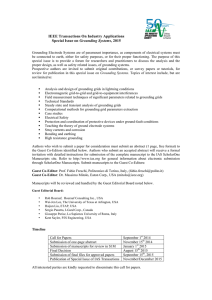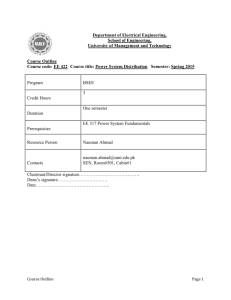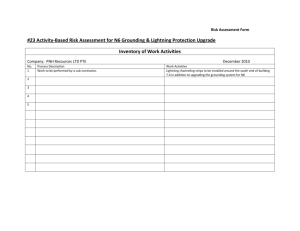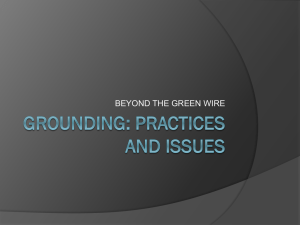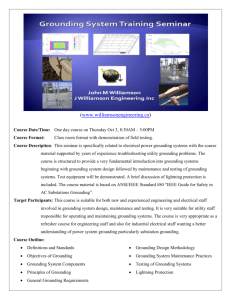Baseline Irrigation Grounding Specification
advertisement
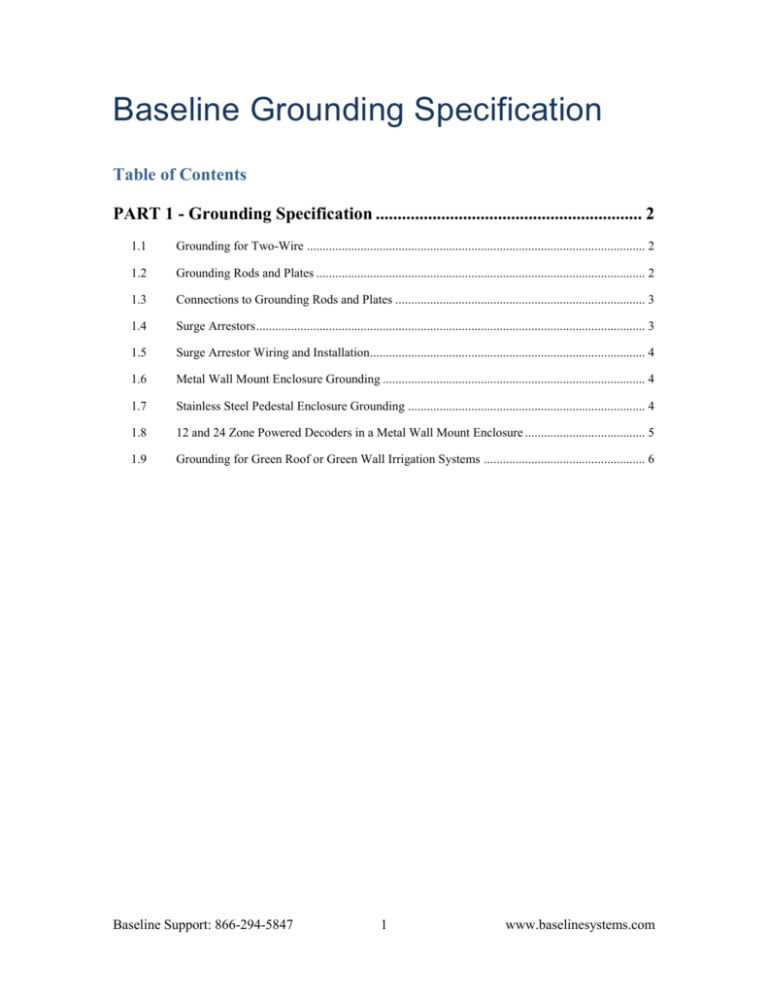
Baseline Grounding Specification Table of Contents PART 1 - Grounding Specification ............................................................. 2 1.1 Grounding for Two-Wire ........................................................................................................... 2 1.2 Grounding Rods and Plates ........................................................................................................ 2 1.3 Connections to Grounding Rods and Plates ............................................................................... 3 1.4 Surge Arrestors ........................................................................................................................... 3 1.5 Surge Arrestor Wiring and Installation....................................................................................... 4 1.6 Metal Wall Mount Enclosure Grounding ................................................................................... 4 1.7 Stainless Steel Pedestal Enclosure Grounding ........................................................................... 4 1.8 12 and 24 Zone Powered Decoders in a Metal Wall Mount Enclosure ...................................... 5 1.9 Grounding for Green Roof or Green Wall Irrigation Systems ................................................... 6 Baseline Support: 866-294-5847 1 www.baselinesystems.com Baseline irrigation controllers shall use the following specifications for grounding: PART 1 - Grounding Specification 1.1 Grounding for Two-Wire A. In all cases, where it does not conflict with appropriate grounding grid design for the site in question, ground rods or plates as referred to in this specification shall conform to the following standards: 1. The installer shall follow manufacturer’s grounding specifications. 2. The installer shall provide adequate earth ground. a. b. 1.2 Resistance readings of 5 to 10 ohms are desirable, and a reading of no more than 25 ohms is required at all grounding points including the twowire and chassis ground. The installer shall comply with practices defined in the American Society of Irrigation Consultants Earth Grounding Guideline 100-2002, available at www.asic.org. 3. The installer shall install a ground rod or ground plate every 600 feet (182.88 m) on the two-wire, and on the end of every spur that exceeds 50 feet (15.24 m). In high lightning areas, grounding should be increased to every 300 feet (91.44 m). 4. Grounding rods or plates shall be located the length of the grounding device away from the two-wire path. There shall be a 6-gauge bare copper wire connecting the grounding rod or plate to the surge arrestor. 5. The surge arrestor shall be located in a valve box and shall not be built into the decoder. Grounding Rods and Plates A. All grounding rods shall be bare copper 5/8 inch (1.6 cm) diameter or greater and a minimum of 8 feet (2.44 m) long or longer. B. A 10-inch (25.4 cm) round valve box shall be installed over the top of the grounding rod to facilitate the use of a clamp-on ground resistance tester. C. All grounding plates shall be a minimum of 5 square feet (1.5 m2) as outlined in ASIC Earth Grounding Guideline 100-2002. D. A 10-inch (25.4 cm) round valve box shall be installed over the top of the ground plate connection to facilitate the use of a clamp-on ground resistance tester. E. Grounding rods and plates shall be located at a minimum distance from the two-wire to assure that the two-wire path is outside of the electrode sphere of influence. For an 8-foot (2.44 m) grounding rod, the grounding rod shall be connected at least 8 feet away from the two-wire path at a right angle to the two-wire path. Baseline Support: 866-294-5847 2 www.baselinesystems.com F. 1.3 Consult the ASIC Earth Grounding Guideline 100-2002 for correct minimum recommended distances for different ground rod or ground plate sizes and grounding grid designs. Connections to Grounding Rods and Plates A. The minimum ground conductor running from the grounding device to the surge arrestor shall be a minimum of a 6-gauge/4.0mm diameter, bare copper wire. B. The ground rod must be buried a minimum of 6 inches (15.24 cm) under the soil. C. All connections to grounding rods or ground plates shall conform to ASIC Earth Grounding Guideline 100-2002, and shall consist of either a CADWELD™ type or screw clamp type of connection that is suitable for direct burial. CADWELD or equivalent connections are preferred. D. The resistance reading at the grounding rod/plate connector shall be less than 1 milliohm. E. Any wire extensions required to connect from a grounding rod or plate to a surge arrestor or enclosure ground lug shall be bare copper. F. The 6-gauge solid conductor shall not exceed a minimum of an 8-inch (20.3 cm) radius bend at any point along the wire. G. There shall only be one mechanical connection on the grounding system. H. All ground lugs shall be made of either copper with stainless steel bolts and copper washers or brass with stainless steel bolts and brass washers. I. All mechanical connections where wires connect shall be cleaned, scored, and covered with antioxidant. J. Wire extensions connected to grounding devices shall use an exothermic weld or screw clamp type connection where the bare copper ground wire meets the green grounding wire from the lightning arrestor. This connection must be suitable for direct burial. Ground hardware shall extend at right angles from the two-wire path. 1.4 Surge Arrestors A. The surge arrestors [BL-LA01 manufactured by Baseline Inc, in Boise, Idaho] shall be fully sealed, submersion proof made for direct bury, and shall effectively seal moisture from electronics. The surge arrestors shall be installed as specified herein. B. The surge arrestor shall come with 2 levels of surge protection that will clamp at 60 volts in less than 1 microsecond. C. The surge arrestor shall clamp closed to dissipate all surges to earth ground and protect other devices on the two-wire. Baseline Support: 866-294-5847 3 www.baselinesystems.com D. Each surge arrestor shall come with 23 inches (58.4 cm) of 16-gauge PVC jacketed solid core wire to connect to the two-wire. E. Each surge arrestor shall come with 23 inches (58.4 cm) of 12-gauge PVC jacketed solid core wire to connect to the ground wire. 1.5 Surge Arrestor Wiring and Installation A. The surge arrestor shall be installed in an appropriate irrigation box and shall be connected to the two-wire in accordance with the manufacturer’s two-wire connector specifications. B. The surge arrestor ground wire shall be connected to a bare copper solid core ground wire using a screw clamp or split bolt type connector (no wire nuts of any kind are supported for grounding wires). The connector shall be installed and insulated according to the manufacturer's specifications. C. The bare copper wire shall be connected to the grounding device using the grounding device specifications. 1.6 Metal Wall Mount Enclosure Grounding A. 1.7 If the controller enclosure is mounted on or within an existing building and does not conflict with appropriate grounding grid design for the site in question, the unit shall be grounded as outlined below: 1. The wall mount cabinet shall come with a built-in ground lug located in the cabinet. 2. The ground lug shall be connected directly to the building ground using a bare copper wire of 6-gauge or, as outlined in article 250 of the National Electric Code (NEC™), such that a single point of connection with the building ground is achieved. 3. The 6-gauge solid conductor may not exceed a minimum of an 8-inch (20.3 cm) radius bend at any point along the wire. 4. The 6-gauge solid conductor shall not be coiled. 5. If the controller enclosure is mounted at a remote location more than 25 feet (7.62 m) away from the building or grounded AC power source, a 6-gauge bare copper grounding wire shall be connected from the ground lug to an appropriate grounding rod as outlined in the sections above. 6. At this grounding point, resistance readings of 5 to 10 ohms are desirable, and a reading of no more than 25 ohms is required. Stainless Steel Pedestal Enclosure Grounding A. If the controller enclosure is within 25 feet (7.62 m) of an existing building, and does not conflict with appropriate grounding grid design for the site in question, the unit shall be grounded as outlined below: Baseline Support: 866-294-5847 4 www.baselinesystems.com 1. B. If the pedestal enclosure is mounted at a remote location, more than 25 feet (7.62 m) away from a building or grounded AC power source, a 6-gauge bare copper grounding shall be connected from the ground lug to an appropriate grounding rod as outlined in the sections above, and in conformance with the ASIC Earth Grounding Guideline 1002002 for controller grounding. 1. The 6-gauge solid conductor may not exceed a minimum of an 8-inch (20.3 cm) radius bend at any point along the wire. 2. C. 1.8 The ground lug, located in the interior on the back panel in the lower-left corner under the AC power box in the pedestal cabinet, shall be connected directly to the building ground using a bare copper wire of 6-gauge or, as outlined in article 250 of the National Electric Code (NEC™) such that a single point of connection with the building ground is achieved. The 6-gauge solid conductor shall not be coiled. At this grounding point, resistance readings of 5 to 10 ohms are desirable, and a reading of no more than 25 ohms is required. 12 and 24 Zone Powered Decoders in a Metal Wall Mount Enclosure A. B. C. If the controller enclosure is being mounted on or within an existing building and does not conflict with appropriate grounding grid design for the site in question, the unit shall be grounded as outlined below: 1. The powered decoder shall come with a built-in surge board that clamps voltage at 60 volts in less than 1 microsecond. 2. The wall mount cabinet shall come with a built-in ground lug located in the cabinet. 3. The ground lug, located in the interior of the cabinet, shall be connected directly to the building ground using a 6-gauge bare copper wire, as outlined in article 250 of the National Electric Code (NEC™), such that a single point of connection with the building ground is achieved. If the controller enclosure is mounted at a remote location more than 25 feet (7.62 m) away from the building or grounded AC power source, a 6-gauge bare copper grounding wire shall be connected from the ground lug to an appropriate grounding rod as outlined in the sections above. 1. The 6-gauge solid conductor may not exceed a minimum of an 8-inch (20.3 cm) radius bend at any point along the wire. 2. The 6-gauge solid conductor shall not be coiled. 3. The powered decoder shall have a ground installed on every sensor port with an installed sensor. The ground shall be installed at the end of the wire run and shall follow manufacturer’s grounding specifications. At this grounding point, resistance readings of 5 to 10 ohms are desirable, and a reading of no more than 25 ohms is required. Baseline Support: 866-294-5847 5 www.baselinesystems.com 1.9 Grounding for Green Roof or Green Wall Irrigation Systems A. When grounding the irrigation system on a green roof or green wall, the green wire from each surge arrestor shall be connected to the building system ground. B. All other requirements in this grounding specification shall apply to the green roof or green wall irrigation system grounding. REV 2.9.2016 Baseline Support: 866-294-5847 6 www.baselinesystems.com

